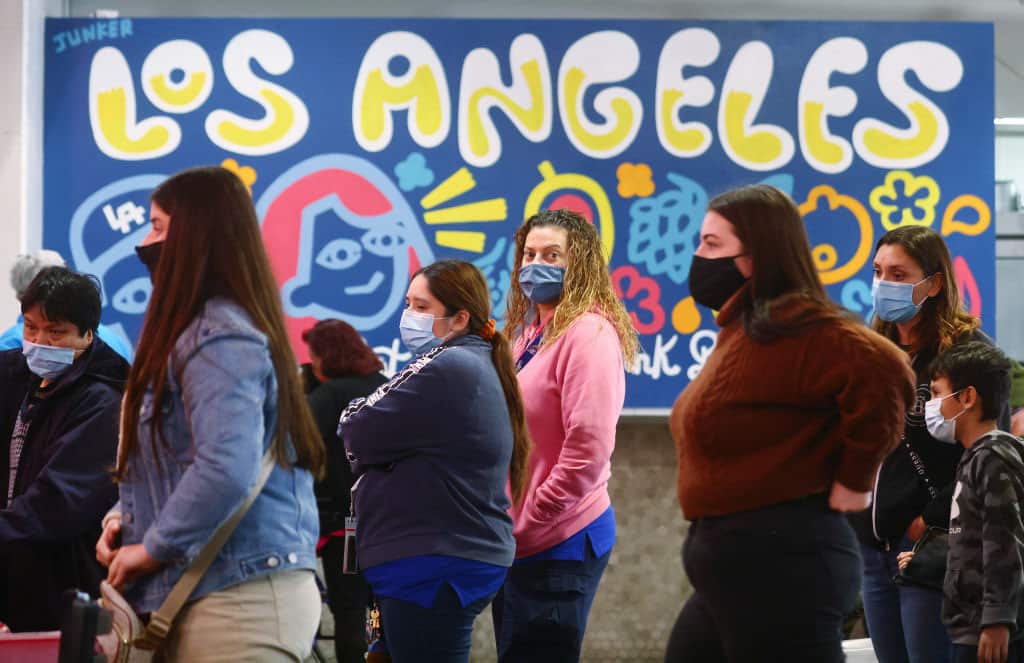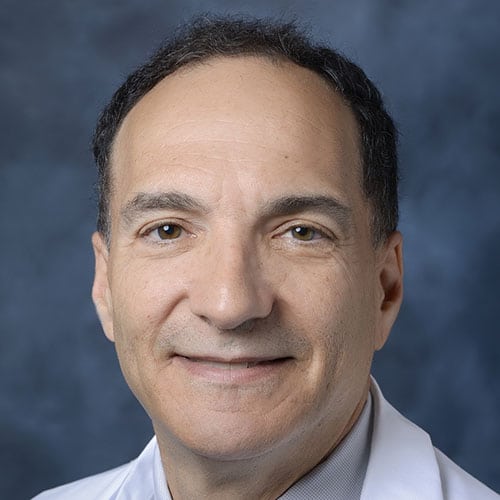 People wear face coverings inside Grand Central Market on December 15, 2021 in Los Angeles, California. (Photo by Mario Tama/Getty Images)
People wear face coverings inside Grand Central Market on December 15, 2021 in Los Angeles, California. (Photo by Mario Tama/Getty Images) COVID update? The eyelids grow heavy. Those that aren’t sick from it are certainly sick of it. Still, there’s enough new to justify a review. Like the proverbial bitter pill COVID currency is good for us.
In researching this column, I read that COVID-19 mortality is 3000-fold greater among 90-year-olds than among teenagers. Five minutes later the phone rang, and a nurse informed me that Marilyn, my 96-year-old mother, just tested positive at her assisted living facility.
The call underlined the perversity of this virus and its ability to surprise and alarm us, both individually and collectively. Still, glimmers of hope penetrate the general rottenness. Although our collective fate placed us among history’s pandemic generations, we’ve fared better than most. Historically we’re doing “pandemic light.” Despite its dogged persistence, relative mortality from COVID remains less than half that of the 1918 flu pandemic. Bubonic plague? The scourge that killed about half of 14th-century Europeans defies comparison with our travails.
In an earlier column I suggested that in the epic contest between a virus and humankind, one should bet on the virus early and on us in the longer run. Two and a half years on, the bet remains a good one. In viewing that bet and the status of the pandemic we need to consider vaccinations, treatments and social measures to reduce transmission and the evolution of the virus.
Vaccinations, developed with record speed, made the largest difference, saving an estimated 14 million lives. Although months of mutations reduced their ability to prevent disease, they remain remarkably effective at reducing death and hospitalization.
Current treatment is primarily oral Paxlovid. Approved only for high-risk populations, it has been shown to reduce both death and hospitalizations. Fortunately, most healthy individuals don’t require it. For those at highest risk, preventive treatment with Evusheld, a combination of two monoclonal antibodies, reduces risk for six months after a single treatment.
Variants produced by mutations continue to “win out,” producing progressively more infectious strains. The current circulating variants, notably the predominant BA.5, all descend from the highly infectious Omicron strain that created havoc in December and January. BA.5 became so prevalent in mid-July that each morning I’d awaken to messages from another crop of newly infected patients. Because viruses that kill their hosts or leave them bedridden impair their own ability to spread, it makes sense that newer and more contagious strains become milder. Consequently, despite extremely high viral prevalence, our local hospital’s COVID census stabilized recently at only a quarter of January’s peak. Another sign of BA.5 mildness are the reports that up to 90% of COVID hospital admissions represent incidentally positive tests in patients admitted for non-COVID issues.
Because viruses that kill their hosts or leave them bedridden impair their own ability to spread, it makes sense that newer and more contagious strains become milder.
So, where is the pandemic heading? Despite COVID capriciousness we can extrapolate cautiously based on recent experience. The virus will likely continue to produce more contagious variants. We can be hopeful that they will also continue to be less lethal. More concerning, the virus is also being selected for the ability to evade immunity and re-infect those with recent infection. This emerging trait will likely increase the population of susceptibles and may allow the virus to continually re-circulate. This trait could produce endemic illness with ongoing risk of cold or flu syndromes requiring periodic vaccinations to prevent more serious illness. In time, it may settle into a milder seasonal pattern, like flu and cold viruses.
Though adherence is tiresome, the ways to stay well remain simple and unchanged. We should keep current with vaccinations and continue to mask in crowded areas, preferably with highly effective masks, such as a K95 or N95. The penalty for a slip-up has become less serious for most: a cold or flu syndrome and some time off. Some, particularly the elderly, immune-impaired and unvaccinated will continue to face mortality risk. Around November an updated vaccine with specific coverage of variants may help us finally move on.
And Marilyn? She started Paxlovid the day after being diagnosed. She had a cough but never had a fever or difficulty with intake of fluids or food. After ten days she came out of isolation. I teased her about being “nonagenarian tough.” Perhaps she was just lucky. Hopefully, luck will soon start circulating as well.
Daniel Stone is Regional Medical Director of Cedars-Sinai Valley Network and a practicing internist and geriatrician with Cedars Sinai Medical Group. The views expressed in this column do not necessarily reflect those of Cedars-Sinai.























 More news and opinions than at a Shabbat dinner, right in your inbox.
More news and opinions than at a Shabbat dinner, right in your inbox.